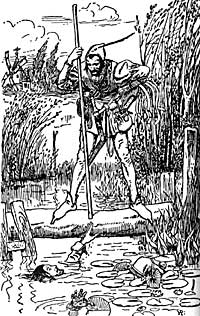

The first meeting of Robin and Little John (Howard Pyle, The Merry Adventures of Robin Hood, 1883).
Archival/written
It is interesting that the earliest accounts of Robin Hood are of a commentary nature, found in a variety of sources including poetry, chronicles and parliamentary rolls. Even more interesting is that the majority of these comments have a derogatory tone, frequently expressing the opinion that Robin Hood, and those who act as legend says he did, are nothing more than robbers and brigands.
In William Langland’s The Vision of Piers Plowman, the character of Sloth tells that while he might not know his Pater Noster perfectly, he does know the rhymes of Robin Hood. This negative association of the outlaw legend is intended to describe to the audience the negligence of the Christina priesthood and the lack of religious devotion exhibited by much of the population, but it also tells us the Robin Hood had already become a figure of popular enthusiasm. A similar tone is taken by the anonymous author of Dives and Pauper, writing between 1405 and 1410 and numerous others such as Alexander Barclay a monk from Ely, who condemned all such tales as ‘fables’, ‘jests’ and ‘trifles’.
The steady pervasion of Robin Hood’s legend can be traced from the thirteenth century: in 1262, for example, the name William ‘Robehod’ was given for a fugitive in the rolls of the exchequer; and the name ‘Gilbert Robynhod’ appeared in a Sussex subsidy roll for 1296, causing Professor Holt, a leading figure on the subject of Robin Hood, to believe that the legend of the outlaw was thus already known in that county prior to that date. The outlaw’s name also appeared in a lawsuit made in the English courts in 1429 with the phrase ‘Robin Hood in Barnsdale stood’. A further reference of a legal nature was made in 1439 when the criminal Piers Venables of Derbyshire and his gang are likened to ‘Robin Hood and his many’. To use the name Robin Hood in this way evidently became a short-hand for criminals, rebels and outlaws, being applied in turn to such personages as Guy Fawkes, Robert Stafford (1417) and Robert Marchall (1497). The quick recognition of this name and the characteristics which it suggests, makes these written documents significant clues as to the widespread early knowledge of the Robin Hood legend.
So popular were the tales of Robin Hood the outlaw that his exploits are even recorded in Scotland. In the Scottish Chronicle composed in the 1440s, one Walter Bower attributes to the year 1226 the rise of the ‘most famous murderer Robin Hood’ and his gang taken from the ‘dispossessed and banished’, the tales of whom were enjoyed only by the ‘foolish’.
However it was also a Scottish author, John Major, who made in 1521 the first positive written commentary on Robin Hood, beginning the tradition which perseveres today of the ‘noble outlaw’ who robs from the rich to give to the poor.
These documents provide a significant clue about the development of the early Robin Hood legend. It is clear that by the early 1400s the tales was already well disseminated and popularly recognisable to the extent that to refer to a man as a ‘Robin hood’ would immediately express that he was a criminal of some form. This is despite the earliest surviving written form of the tales, the first surviving manuscript of Robin Hood and the Monk, dating from no earlier than the mid-fifteenth century. A second manuscript, Robin Hood and the Potter, is later still, being attributed to the late fifteenth/early sixteenth century, and is today to be found in the Cambridge University Library.
References
- D. Crook, ‘Some further evidence concerning the dating of the origins of the legend of Robin Hood’, in the English Historical Review 99:3 (1984), pp. 530-4.
- R. B. Dobson and J. Taylor, Rymes of Robin Hood (1997)
- William Langland, The Vision of Piers Plowman
- Robin Hood and the Monk:
Original Manuscript at Cambridge University Library, MS. Ff.5.48, fos.128v-135v.
- Robin Hood and the Potter:
Original Manuscript at Cambridge University Library, MS.Ee.4.35, fos.14v.-19r.
- Reference from three Scottish fifteenth and sixteenth century chronicles can be found at the University of Rochester’s webpage: www.lib.rochester.edu/camelot/rh/rhaumenu.htm